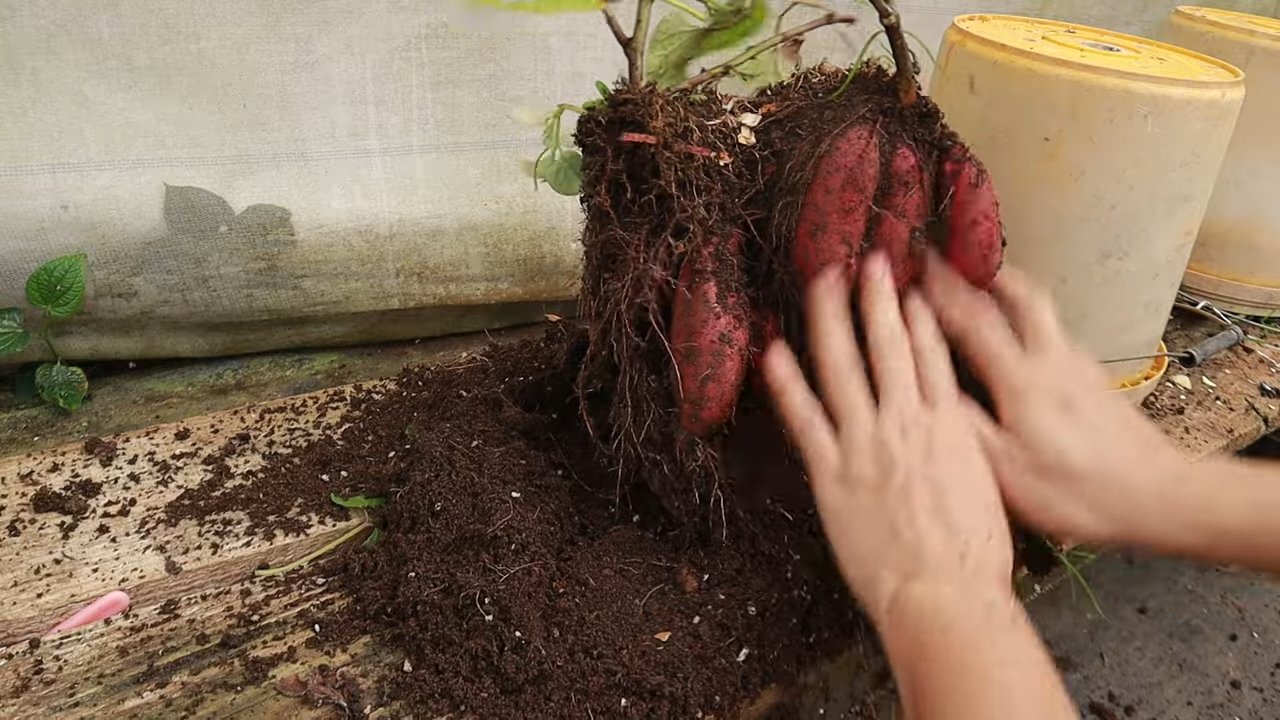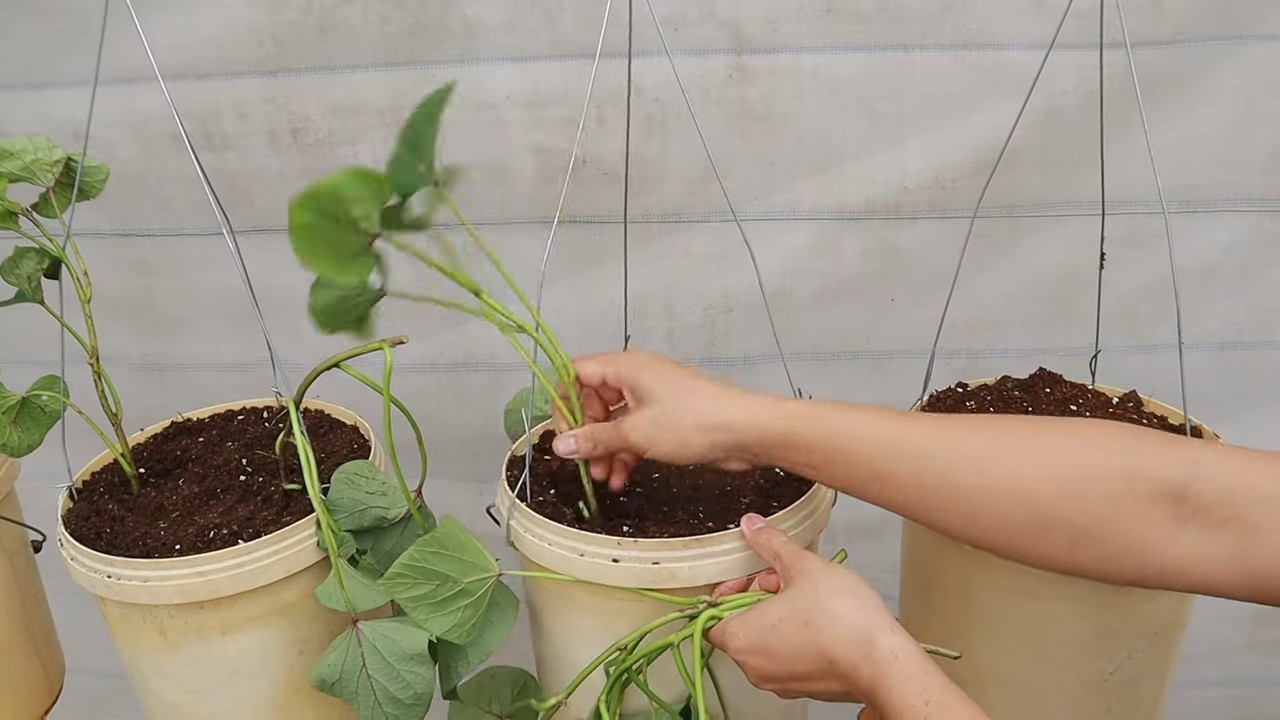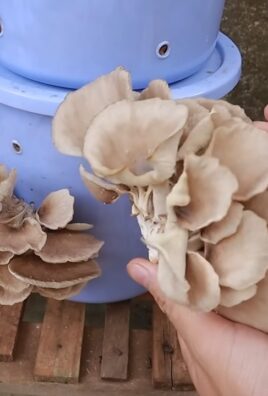Sweet Potato Vertical Tower Yield: Dreaming of a bountiful sweet potato harvest but short on space? You’re not alone! For centuries, gardeners have sought innovative ways to maximize their yields, and the vertical garden is a testament to that ingenuity. From the Hanging Gardens of Babylon to modern-day urban farms, the desire to cultivate upwards has always been strong. But let’s face it, traditional sweet potato patches can take up a *lot* of valuable garden real estate.
That’s where this DIY sweet potato vertical tower comes in! I’m going to show you how to build a simple, space-saving structure that will not only look fantastic but also dramatically increase your sweet potato vertical tower yield. Imagine harvesting a mountain of delicious, homegrown sweet potatoes from a single, compact tower. Sounds good, right?
Many people struggle with limited garden space, poor soil conditions, or even just the sheer volume of vines sweet potatoes produce. This DIY project tackles all those problems head-on. By growing vertically, you’ll save space, improve drainage, and create a beautiful focal point in your garden. Plus, it’s a fun and rewarding project that anyone can tackle, regardless of their gardening experience. So, let’s get started and unlock the secrets to a truly impressive sweet potato harvest!

DIY Sweet Potato Vertical Tower for a Bountiful Harvest
Hello dear garden friends! Do you also have very little space in the garden but still want a bountiful sweet potato harvest? Then I have just the thing for you: a DIY sweet potato vertical tower! This space-saving solution is not only super practical but also a real eye-catcher. I’ll show you how you can easily build this tower yourself. Let’s get started!
What you need:
- Several large plant pots (at least 40 cm in diameter), ideally made of plastic as they are lighter. The number depends on the desired height of the tower. I recommend at least 3-4 pots.
- A drill with a hole saw attachment (approx. 10-15 cm in diameter) or a jigsaw.
- Garden soil (a mixture of compost, potting soil, and sand is best).
- Sweet potato slips (preferably pre-grown plants from a garden center or self-propagated).
- Watering can or garden hose.
- Optional: Weed fleece or jute to line the pots.
- Optional: Fertilizer for sweet potatoes (slow-release fertilizer is ideal).
- Optional: Gloves to keep your hands clean.
- Optional: A shovel or spade for filling the pots.
- Optional: A spirit level to ensure the pots are standing straight.
The Preparation:
Before we start building, it’s important to prepare everything. This saves time and nerves.
- Clean the pots: Thoroughly clean all plant pots with water and possibly a little soap. This removes dirt and any potential pathogens.
- Choose a location: Find a sunny spot for your vertical tower. Sweet potatoes love the sun! Make sure the location is also easily accessible so you can water and care for the plants without problems.
- Have materials ready: Lay out all materials and tools so you have them at hand.
Step-by-Step Guide: Building the Vertical Tower
- Prepare the bottom pot: The bottom pot forms the base of our tower. Fill it about one-third full with garden soil. You can use weed fleece or jute here to prevent soil from trickling through the drainage holes.
- Drill holes in the pots: Now comes the tricky part: we need to drill holes in the sides of the remaining pots. These holes will serve as planting openings for the sweet potatoes.
- Mark the hole positions: Mark the spots where you want to drill the holes with a pen. Make sure the holes are evenly distributed and have enough distance from each other (approx. 20-30 cm). I recommend arranging the holes in a staggered pattern so the plants have enough space later.
- Drill the holes: Use the hole saw or jigsaw to drill the holes in the pots. Be careful and work slowly to avoid tearing the plastic. It’s best to wear safety glasses to protect your eyes from flying debris.
- Place and fill the second pot: Place the second pot on top of the first. Make sure it is stable. Fill the second pot with garden soil as well, until the holes are about half-covered.
- Stack and fill the remaining pots: Repeat step 3 for all remaining pots. The higher the tower gets, the more important it is to ensure stability. You can additionally connect the pots with cable ties or wire to secure them.
- Fill the top pot: The top pot is completely filled with garden soil. We will also plant sweet potatoes here later.
The Planting: Inserting Sweet Potatoes
- Prepare the sweet potato slips: Before you plant the slips, you should briefly place them in water so they can soak it up.
- Place plants in the holes: Carefully insert the sweet potato slips into the holes on the sides of the pots. Make sure the roots are well covered with soil.
- Plant in the top pot: Also plant sweet potato slips in the top pot. You can plant a few more here, as there is more space.
- Water thoroughly: Water all plants thoroughly. This helps them to establish themselves in their new location.
The Care: Keeping Your Sweet Potatoes Happy
- Regular watering: Sweet potatoes need regular water, especially during the hot summer months. Make sure the soil is always moist, but not wet.
- Fertilizing: Sweet potatoes are heavy feeders and need sufficient nutrients. Fertilize them regularly with a special sweet potato fertilizer or an organic fertilizer.
- Remove weeds: Regularly remove any weeds that grow in the tower. Weeds compete with the sweet potatoes for nutrients and water.
- Control pests: Watch out for pests like aphids or slugs. If necessary, you can use biological pesticides.
- Guide vines: Sweet potatoes form long vines. You can either guide these vines along the tower or just let them hang down.
The Harvest: The Reward for Your Effort
- Determine harvest time: Sweet potatoes are ready to harvest when the leaves turn yellow and die back. This is usually in the fall, just before the first frost.
- Carry out the harvest: Carefully dig out the sweet potatoes. Be gentle to avoid damaging the tubers.
- Dry the sweet potatoes: Let the harvested sweet potatoes dry for a few days in a dry and airy place. This makes them more durable and helps them develop their sweet taste.
- Store: Store the dried sweet potatoes in a cool, dark place. They will keep for several months this way.
Additional Tips and Tricks:
- Variety selection: Choose sweet potato varieties that are suitable for container growing. There are varieties that grow more compactly and are better suited for pot cultivation.
- Drainage: Make sure the pots have good drainage so that water can run off well.
- Mulching: Mulch the soil in the tower with straw or bark mulch. This keeps the moisture in the soil and suppresses weeds.
- Overwintering: In cold regions, you should harvest the sweet potatoes before the first frost and store the tubers indoors. You can leave the pots outside during the winter.
- Creativity: Be creative in designing your vertical tower! You can paint the pots in different colors or combine them with other plants.
I hope this guide helps you build your own sweet potato vertical tower. It’s a great project that is not only fun but also promises a rich harvest. Good luck and have fun gardening

Conclusion
So, there you have it! Building your own sweet potato vertical tower is more than just a gardening project; it’s an investment in fresh, delicious produce, a space-saving solution, and a rewarding experience that connects you directly to the food you eat. We’ve walked you through the process, highlighting the ease and affordability of this method. But why is this DIY trick a must-try?
Firstly, consider the yield. A traditional garden plot dedicated to sweet potatoes requires significant space. With a vertical tower, you can dramatically increase your sweet potato harvest in a fraction of the area. This is particularly beneficial for urban gardeners, apartment dwellers with balconies, or anyone with limited yard space. Imagine the satisfaction of harvesting a bountiful crop of sweet potatoes from a single, compact structure!
Secondly, think about the convenience. Vertical gardening reduces bending and kneeling, making it easier on your back and joints. Harvesting is also simplified, as the sweet potatoes are readily accessible within the tower. No more digging through sprawling vines!
Thirdly, it’s a cost-effective solution. The materials required are relatively inexpensive, especially if you repurpose items you already have around the house. Compared to purchasing sweet potatoes regularly from the grocery store, the savings can add up quickly.
But the benefits don’t stop there. A sweet potato vertical tower is also a visually appealing addition to your garden or outdoor space. The cascading vines and vibrant foliage create a beautiful and unique display. It’s a conversation starter and a testament to your ingenuity.
Now, let’s talk about variations. While we’ve focused on using specific materials, feel free to experiment with what you have available. You could use different types of containers, such as plastic bins or even repurposed tires (ensure they are safe and non-toxic). You can also adjust the size and height of the tower to suit your specific needs and preferences. Consider adding companion plants, such as herbs or flowers, to attract pollinators and deter pests. Marigolds, for example, are known to repel nematodes, which can damage sweet potato roots.
Another exciting variation is to experiment with different varieties of sweet potatoes. There are numerous cultivars available, each with its own unique flavor, texture, and color. From the classic orange Beauregard to the purple Okinawan, the possibilities are endless.
We strongly encourage you to give this DIY sweet potato vertical tower a try. It’s a fun, rewarding, and sustainable way to grow your own food. Don’t be afraid to get creative and personalize your tower to reflect your own style and preferences.
Once you’ve built your tower and harvested your sweet potatoes, we’d love to hear about your experience! Share your photos, tips, and tricks with us on social media using [Your Hashtag]. Let’s build a community of vertical sweet potato gardeners and inspire others to embrace this innovative growing method. We are confident that you will find that growing sweet potatoes in a vertical tower is a game-changer. Happy gardening!
Frequently Asked Questions (FAQ)
What type of soil should I use for my sweet potato vertical tower?
Sweet potatoes thrive in well-draining, sandy loam soil. Avoid heavy clay soils, as they can become waterlogged and inhibit root development. A good mix would be equal parts garden soil, compost, and sand or perlite. The compost provides essential nutrients, while the sand or perlite improves drainage. You can also purchase a pre-mixed potting soil specifically formulated for vegetables. Ensure the soil is slightly acidic, with a pH between 6.0 and 6.5. Before planting, amend the soil with a slow-release fertilizer to provide a steady supply of nutrients throughout the growing season.
How often should I water my sweet potato vertical tower?
Watering frequency depends on several factors, inc
So, there you have it! Building your own sweet potato vertical tower is more than just a gardening project; it’s an investment in fresh, delicious produce, a space-saving solution, and a rewarding experience that connects you directly to the food you eat. We’ve walked you through the process, highlighting the ease and affordability of this method. But why is this DIY trick a must-try?
Firstly, consider the yield. A traditional garden plot dedicated to sweet potatoes requires significant space. With a vertical tower, you can dramatically increase your sweet potato harvest in a fraction of the area. This is particularly beneficial for urban gardeners, apartment dwellers with balconies, or anyone with limited yard space. Imagine the satisfaction of harvesting a bountiful crop of sweet potatoes from a single, compact structure!
Secondly, think about the convenience. Vertical gardening reduces bending and kneeling, making it easier on your back and joints. Harvesting is also simplified, as the sweet potatoes are readily accessible within the tower. No more digging through sprawling vines!
Thirdly, it’s a cost-effective solution. The materials required are relatively inexpensive, especially if you repurpose items you already have around the house. Compared to purchasing sweet potatoes regularly from the grocery store, the savings can add up quickly.
But the benefits don’t stop there. A sweet potato vertical tower is also a visually appealing addition to your garden or outdoor space. The cascading vines and vibrant foliage create a beautiful and unique display. It’s a conversation starter and a testament to your ingenuity.
Now, let’s talk about variations. While we’ve focused on using specific materials, feel free to experiment with what you have available. You could use different types of containers, such as plastic bins or even repurposed tires (ensure they are safe and non-toxic). You can also adjust the size and height of the tower to suit your specific needs and preferences. Consider adding companion plants, such as herbs or flowers, to attract pollinators and deter pests. Marigolds, for example, are known to repel nematodes, which can damage sweet potato roots.
Another exciting variation is to experiment with different varieties of sweet potatoes. There are numerous cultivars available, each with its own unique flavor, texture, and color. From the classic orange Beauregard to the purple Okinawan, the possibilities are endless.
We strongly encourage you to give this DIY sweet potato vertical tower a try. It’s a fun, rewarding, and sustainable way to grow your own food. Don’t be afraid to get creative and personalize your tower to reflect your own style and preferences.
Once you’ve built your tower and harvested your sweet potatoes, we’d love to hear about your experience! Share your photos, tips, and tricks with us on social media using [Your Hashtag]. Let’s build a community of vertical sweet potato gardeners and inspire others to embrace this innovative growing method. We are confident that you will find that growing sweet potatoes in a vertical tower is a game-changer. Happy gardening!
Frequently Asked Questions (FAQ)
What type of soil should I use for my sweet potato vertical tower?
Sweet potatoes thrive in well-draining, sandy loam soil. Avoid heavy clay soils, as they can become waterlogged and inhibit root development. A good mix would be equal parts garden soil, compost, and sand or perlite. The compost provides essential nutrients, while the sand or perlite improves drainage. You can also purchase a pre-mixed potting soil specifically formulated for vegetables. Ensure the soil is slightly acidic, with a pH between 6.0 and 6.5. Before planting, amend the soil with a slow-release fertilizer to provide a steady supply of nutrients throughout the growing season.
How often should I water my sweet potato vertical tower?
Watering frequency depends on several factors, including the weather, the type of soil, and the size of the tower. Generally, you should water deeply whenever the top inch of soil feels dry to the touch. During hot, dry weather, you may need to water daily. Avoid overwatering, as this can lead to root rot. Ensure the tower has adequate drainage to prevent water from pooling at the bottom. A good way to check if your sweet potatoes are getting enough water is to observe the leaves. If they are wilting or turning yellow, it’s a sign that they need more water. Conversely, if the leaves are consistently soggy or waterlogged, you may be overwatering.
How much sunlight do sweet potatoes need?
Sweet potatoes require at least 6-8 hours of direct sunlight per day to thrive. Choose a location for your vertical tower that receives ample sunlight throughout the growing season. If you live in a particularly hot climate, some afternoon shade may be beneficial to prevent the plants from overheating. If you don’t have a sunny location, you can supplement with grow lights. Position the grow lights close to the plants and adjust the height as they grow.
When is the best time to plant sweet potatoes in a vertical tower?
The best time to plant sweet potatoes is after the last frost, when the soil has warmed to at least 65 degrees Fahrenheit. Sweet potatoes are sensitive to cold temperatures, so it’s important to wait until the weather is consistently warm before planting. In cooler climates, you may need to start your sweet potato slips indoors several weeks before the last frost. This will give them a head start and ensure they are ready to transplant when the weather is favorable.
How do I harvest sweet potatoes from a vertical tower?
Sweet potatoes are typically ready to harvest about 90-120 days after planting. The leaves will start to turn yellow and the vines will begin to die back. To harvest, carefully dismantle the tower, starting from the top. Gently remove the soil and locate the sweet potatoes. Be careful not to damage the potatoes as you dig them out. Once harvested, cure the sweet potatoes for 7-10 days in a warm, humid place. This will help to heal any cuts or bruises and improve their flavor and storage life.
What are some common pests and diseases that affect sweet potatoes?
Some common pests that affect sweet potatoes include sweet potato weevils, flea beetles, and nematodes. Diseases include stem rot, black rot, and scurf. To prevent pests and diseases, use disease-resistant varieties, practice crop rotation, and maintain good soil health. You can also use organic pest control methods, such as neem oil or insecticidal soap. Regularly inspect your plants for signs of pests or diseases and take action promptly to prevent them from spreading.
Can I grow other vegetables in a vertical tower alongside sweet potatoes?
While it’s possible to grow other vegetables in a vertical tower alongside sweet potatoes, it’s important to choose companion plants that won’t compete for resources or attract pests that could harm the sweet potatoes. Good companion plants for sweet potatoes include marigolds, nasturtiums, and herbs like basil and oregano. These plants can help to repel pests and attract beneficial insects. Avoid planting aggressive growers or plants that require a lot of water, as they could compete with the sweet potatoes.
How do I store sweet potatoes after harvesting?
After curing, store sweet potatoes in a cool, dry, and dark place with good ventilation. The ideal storage temperature is between 55 and 60 degrees Fahrenheit. Avoid storing sweet potatoes in the refrigerator, as this can cause them to develop a hard core and lose their flavor. Properly stored sweet potatoes can last for several months. Check them periodically for signs of spoilage and discard any that are soft or moldy.





Leave a Comment